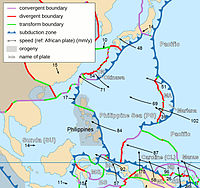
Photo from wikipedia
Abstract The Huai’an Complex in the north-western Trans-North China Orogen, North China Craton is recognized to have undergone high-pressure metamorphism with controversial ages. Two mafic granulite samples (17HT13 and 16HT22)… Click to show full abstract
Abstract The Huai’an Complex in the north-western Trans-North China Orogen, North China Craton is recognized to have undergone high-pressure metamorphism with controversial ages. Two mafic granulite samples (17HT13 and 16HT22) from Huangtuyao of the Huai’an Complex are documented for metamorphism based on petrography, mineral chemistry, phase equilibria modelling and zircon dating. The rocks comprise garnet, clinopyroxene, orthopyroxene, amphibole, plagioclase and ilmenite. They show clockwise P-T paths involving the pre-Tmax decompressional heating, the Tmax and the post-Tmax cooling stages. The pre-Tmax decompressional heating is revealed by the core-rim/mantle anorthite-ascending zoning in coarse-grained plagioclase. The Tmax stage is constrained to 8.5–10.5 kbar/980–1010 °C (17HT13) and 7.5–9.5 kbar/1000–1030 °C (16HT22) by the high Ti content of amphibole, and the anorthite content of coarse-grained plagioclase rims/mantles and fine-grained plagioclase cores. These temperatures are slightly higher than the results of amphibole thermometers (∼940–980 °C). The post-Tmax cooling is defined by the later growth of amphibole and some conventional geothermobarometers. Because it is dominated by temperature with ilmenite present, the Ti content of amphibole is proposed as a reliable thermometer, and the Ti-rich amphibole with Ti > 0.28 p.f.u. or TiO2 > 2.4–2.6 wt% is indicative of ultrahigh-temperature (>900 °C, UHT) conditions. The anorthite content of plagioclase is also significant in confining peak temperatures for UHT granulite but requires defining proper water content. Zircon dating for 17HT13 yields an upper intercept age of 1910 ± 35 Ma, representing the cooling of UHT granulite. We conclude that the Huai’an Complex may have at least locally undergone UHT metamorphism at ∼1.92–1.91 Ga after high-pressure granulite metamorphism at ∼1.95 Ga, similar to the Jining Complex. Therefore, the Huai’an and Jining Complexes share the same tectonic evolution involving ∼1.95 Ga crustal thickening, ∼1.92–1.91 Ga extension with regional or local UHT metamorphism, and subsequent cooling and uplifting.
Journal Title: Gondwana Research
Year Published: 2019
Link to full text (if available)
Share on Social Media: Sign Up to like & get
recommendations!